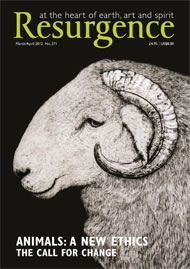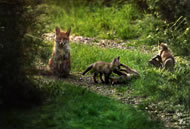Years ago, as I was walking early one morning through some woods in southern Switzerland, I came to a clearing overlooking a valley. The view was so spectacular that I sat down just to admire the beauty of the whole scene. The morning’s walk had tired me more than I thought, and I promptly fell into a doze. When I awoke I quickly realised that I was not alone: a fox had stationed herself between me and the cliff, and was leisurely looking out over the same view that I enjoyed. As I watched the fox taking in the scene, a delightful thing happened: the sun came up over the mountain, and as it lit up the valley, the various churches began ringing their bells – for it was Easter morning. After a few moments, the fox stood up and trotted down the path, then through a vineyard and disappeared into some trees, never once looking at me or acting as though she even knew of my presence. I felt a strong desire to follow her, to try to find out where she had gone. But the rows of vines posed an obstacle for me, and when I came to the trees I saw that the ground sloped so precipitously that I could go no farther.
That’s a story I’ve told many times. The experience has lost none of its vividness. The brilliance and richness of the fox’s coat, her smell, her apparent appreciation of natural beauty, the ease with which she trotted through that row of vines, the sinuosity with which she seemed to weave herself into the trees are all details I have kept as a cherished memory. The experience changed me. At first, certain that everything in the world somehow had to refer to me, I saw in the event a coherence; it served up a kind of allegory: the fox, the appearance of the sun, the ringing of the bells. I was convinced it represented a call.
It was the time, as well, when I was first learning to read poetry, to listen to music, and to look at art, to find delight in the surprising relatedness of things. My aesthetic education had led me to see the fox as part of a whole tableau – the valley with its varied villages, the morning light, the foreground of vineyard and trees, and, of course, the details of the fox’s brilliant colouring, texture, shape and movement. My deep connectedness and responsiveness to Nature were shaped utterly by my burgeoning aesthetic sensibility, which found a relatedness among the parts of a unified tableau.
Had I trained as a field biologist, I might have told a completely different story of that morning, and of the fox. I might have assumed she (for I would certainly have noted her gender) was finishing up a night’s hunting and returning to her den, where her kits were waiting for her. I might have classified her markings according to the range of known possibilities among the Vulpes vulpes of the region. And I might have taken note especially of the characteristic way she smelled the wind to judge what predators or prey lay before her, and how her movements through the vineyard and the trees were managed strategically as camouflage to blend her with the shadows. And if I had had both the acuteness of observation and the stamina of David Macdonald, whose admirable book Running with the Fox relates the experience of sharing nocturnal hunts with a befriended fox, then I could have described in precise and concrete terms the reality of a fox in her natural environment.
But how much closer to the real fox would I have got?
In the community of people who work with horses, the ideal horse person is often described as a ‘quiet’ rider. And the great dressage trainer Sally Swift has suggested that a way to achieve quietness is to learn to see with “soft eyes”. By this she means that we begin heeding those things that pass only in the periphery of our vision. She bases her teaching on a belief that this is how horses see, and that the best way to be with them is to accommodate our habits of seeing to theirs. I have always thought that an oblique quietness could extend to our relations with other animals as well – and especially to a fox.
Across different cultures foxes have traditionally been associated with a kind of intelligence that does not seek straight lines. In the West this is called cunning, and has been held in disrepute. But I would suggest that if we forget the negative associations, just as we might overlook a fox’s smell or her scruffy appearance, we might discover a way of being with foxes that would move us beyond all anthropocentric insistence on giving primacy to reason; a mode of living alongside another being without having to ask what that being means to us or how it might serve us. It would also mean devising new stories about foxes and other animals, and new ways of telling those stories. Meeting a fox early one morning would not be about anything other than the simple fact that two beings shared a common space for a beautiful moment.








